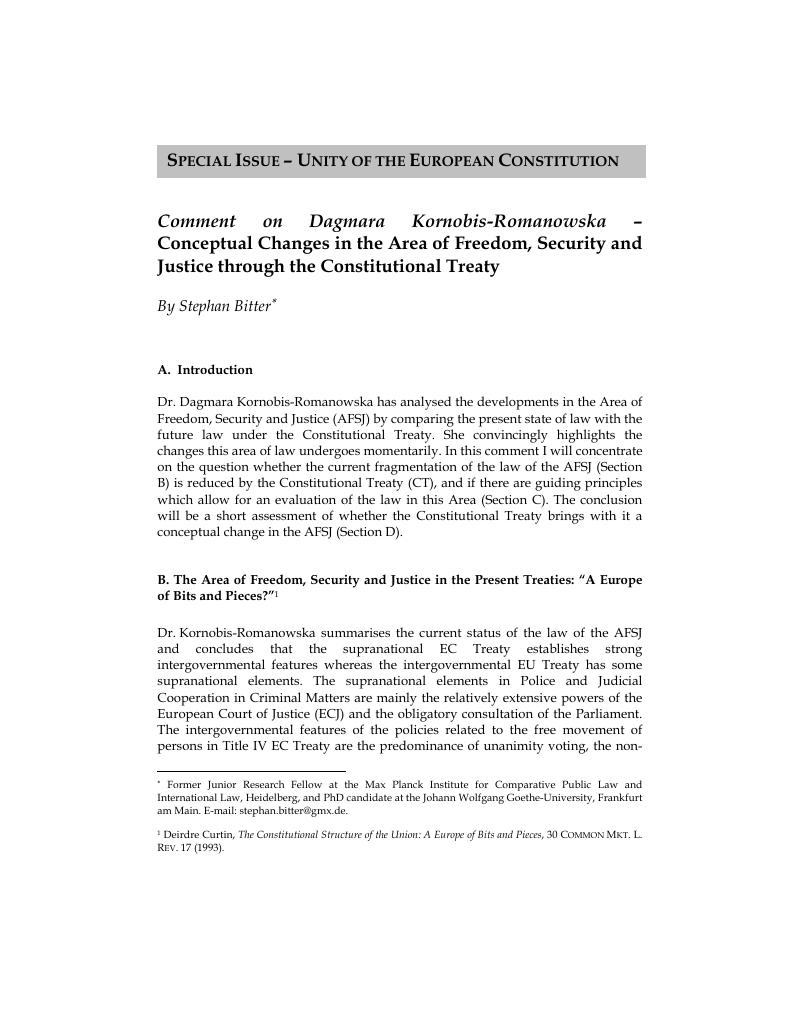No CrossRef data available.
Article contents
Comment on Dagmara Kornobis-Romanowska – Conceptual Changes in the Area of Freedom, Security and Justice through the Constitutional Treaty
Published online by Cambridge University Press: 06 March 2019
Abstract

- Type
- Part III: Sectoral Differentiation in the Constitution
- Information
- German Law Journal , Volume 6 , Issue 11: The Unity of the European Constitution: 2nd German-Polish Seminar on the Constitutional Law of the European Union , 01 November 2005 , pp. 1641 - 1647
- Copyright
- Copyright © 2005 by German Law Journal GbR
References
1 Curtin, Deirdre, The Constitutional Structure of the Union: A Europe of Bits and Pieces, 30 Common Mkt. L. Rev. 17 (1993).Google Scholar
2 For example, if obligatory consultation really is a characteristic of supranational law-making.Google Scholar
3 See Peter-Christian Müller-Graff, Der “Raum der Freiheit, der Sicherheit und des Rechts” im neuen Verfassungsvertrag für Europa, in Europa und seine Verfassung. Festschrift für Manfred Zuleeg 605, 610-611 (Charlotte Gaitanides, Stefan Kadelbach & Gil Carlos Rodriguez Iglesias eds., 2005).Google Scholar
4 See The Action Plan of the Council and the Commission on how best to implement the provisions of the Treaty of Amsterdam on an area of freedom, security and justice, 1999 O.J. (C 19) 1; Presidency Conclusions, Tampere European Council, (Oct. 15-16, 1999), available at http://ue.eu.int/ueDocs/cms_Data/docs/pressData/en/ec/00200-r1.en9.htm.Google Scholar
5 See White, Simone, European Constitution: What is new in the Area of Judicial Co-operation in Criminal Matters and Police Co-operation, The Federal Trust for Education & Research, July 2004, at 5, available at http://www.fedtrust.co.uk/uploads/constitution/07_04.pdf; Daniel Thym, The Area of Freedom, Security and Justice in the Treaty Establishing a Constitution for Europe, Walter-Hallstein-Institut für Europäisches Verfassungsrecht, Dec. 2004, at 4, available at http://www.rewi.hu-berlin.de/WHI/deutsch/papers/whipapers1204/index.htm.Google Scholar
6 Case C-105/03, Pupino, 2005 E.C.R. I-0000, paras. 39-42, available at http://europa.eu.int/smartapi/cgi/sga_doc?smartapi!celexplus!prod!CELEXnumdoc&lg=en&numdoc =62003J0105.Google Scholar
7 Case 120/78, Rewe-Zentral v. Bundesmonopolverwaltung für Branntwein, 1979 E.C.R. 649 (concerning free movement of goods). The application of this principle was later extended in secondary law to the free movement of persons. See Council Directive 89/48, 1989 O.J. (L 19) 16 (on a general system for the recognition of higher-education diplomas awarded on completion of professional education and training of at least three years’ duration).Google Scholar
8 Joined Cases C-187/01 and C-385/01, Gözütok and Brügge, 2003 E.C.R. I-1345, para. 33 (The ECJ already applies the concept of mutual trust in criminal matters).Google Scholar
9 But see Peers, Steve, Mutual Recognition and Criminal Law in the European Union: Has the Council Got it Wrong?, 41 Common Mkt. L. Rev. 5 (2004).Google Scholar
10 See Bitter, Stephan, Zwangsmittel im Recht der Europäischen Union: Geteilte Rechtsmacht in Europa, in Europa als Raum der Freiheit, der Sicherheit und des Rechts (Rainer Hofmann & Stefan Kadelbach eds., forthcoming 2005).Google Scholar
11 Joined Cases C-187/01 and C-385/01, Gözütok and Brügge, 2003 E.C.R. I-1345, para. 34 (The European judicature applied the principle of mutual recognition for the benefit of the individual).Google Scholar
12 Albrecht, Peter-Alexis & Braum, Stefan, Deficiencies in the Development of European Criminal Law, 5 Eur. L. J. 293, 294 (1999); European Union Committee, The Hague Programme: A Five year Agenda for EU Justice and Home Affairs, 2004-5, H.L. 24, at paras. 10-11, available at http://www.publications.parliament.uk/pa/ld200405/ldselect/ldeucom/84/84.pdf.Google Scholar
13 Council Framework Decision 2002/584, 2002 O.J. (L 190) 1 (JHA) (on the European arrest warrant and the surrender procedures between Member States).Google Scholar
14 Judgment of the Polish Constitutional Tribunal of April 27, 2005, P 1/05, available at http://www.trybunal.gov.pl/eng/summaries/documents/P_1_05_GB.pdf; BVerfG, 2 BvR 2236/04 of July 18, 2005, available at http://www.bverfg.de/entscheidungen/rs20050718_2bvr223604.html.Google Scholar
15 Peers, , supra note 9, at 24.Google Scholar
16 Council Framework Decision 2005/214, 2005 O.J. (L 76) 16 (JHA) (on the application of the principle of mutual recognition to financial penalties).Google Scholar
17 See Douglas-Scott, Sionaidh, The Rule of Law in the European Union – Putting the Security into the “Area of Freedom, Security and Justice,” 29 Eur. L. Rev. 219, 226-227 (2004). Concerning the European Arrest Warrant, these concerns appear to be at least partially justified as recent Austrian-German cases seem to illustrate. See Der Spiegel No. 23/2005, 106, 118–119.Google Scholar
18 Proposal for a Council Framework Decision on Certain Procedural Rights in Criminal Proceedings Throughout the European Union, COM (2004) 328 final (April 28, 2004).Google Scholar
19 Wouters, Jan & Naert, Frederik, Of Arrest Warrants, Terrorist Offences and Extradition Deals, 41 Common Mkt. L. Rev. 909, 924-925 (2004).Google Scholar
20 Maria Kaiafa-Gbandi, Europäisches Strafrecht – Die Perspektive des Grundrechtsschutzes nach dem Verfassungsentwurf für Europa, Kritische Vierteljahresschrift für Gesetzgebung und Rechtswissenschaft 3, 20-22 (2004).Google Scholar
21 Gesetz über die internationale Rechtshilfe in Strafsachen, Aug. 24, 2004 BGBl I 1748, 1749, available at http://bundesrecht.juris.de/bundesrecht/irg/inhalt.html.Google Scholar
22 Oberlandesgericht [OLG] Stuttgart, Neue Juristische Wochenschrift 57 (2004), 3437, 3439; Nicola Vennemann, The European Arrest Warrant and Its Human Rights Implications, 63 Zeitschrift für ausländisches öffentliches Recht und Völkerrecht [Heidelberg J. Int'l L.] 103, 115 (2003) (suggesting this approach).Google Scholar
23 See Bast, Jürgen, The Constitutional Treaty as a Reflexive Constitution, in this volume.Google Scholar
24 Jean Pradel & Geert Corstens, Droit Pénal Européen 3-5 (1999); Albrecht & Braum, supra note 12, at 297–299; European Union Committee, supra note 12, at para. 40.Google Scholar
25 See Bast, , supra note 23.Google Scholar
26 See Thym, , supra note 5, at 13-14.Google Scholar
27 See Albrecht, Peter-Alexis, 11 Propositions Toward the Development of Legal Foundations for European Criminal Law, 84 Kritische Vierteljahresschrift für Gesetzgebung und Rechtswissenschaft 269, 275 (2001).Google Scholar
28 Müller-Graff, supra note 3, at 610-611.Google Scholar




